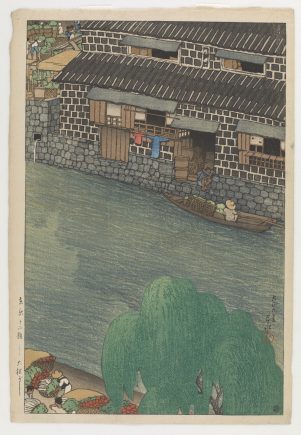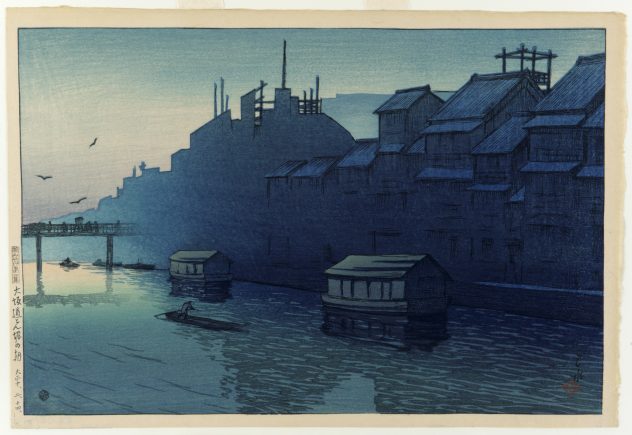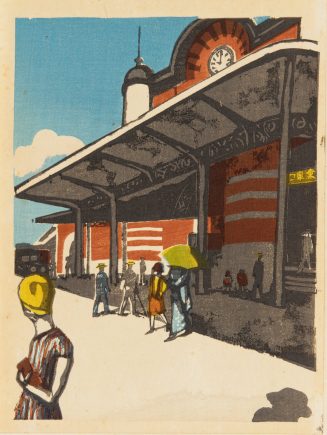September 29, 2018–January 24, 2019
-
Dates
-
Location
Arthur M. Sackler Gallery
-
Collection Area
Contemporary Art, Japanese Art
When photography arrived in Japan in the mid-nineteenth century, traditional woodblock printmakers were forced to adapt their craft to keep pace with the new medium. In the decades that followed, major upheavals—a new system of government, a devastating earthquake, and the onset of world war—continued to influence Japanese prints. This exhibition explores Japanese artists’ reactions to the challenges of modernity from the late nineteenth to mid-twentieth century. It first examines the collapse of the traditional woodblock-printmaking industry in the face of the printing press and photography. Then, it traces the medium’s resurrection as an art form, through which printmakers recorded scenes of their changing country in striking new ways. Complemented by Japan Modern: Photography from the Gloria Katz and Willard Huyck Collection
-

S2003.8.144
Shinbashi Railway Station
Utagawa Hiroshige III (1843–1894)
Japan, 1873
Woodblock print; ink and color on paper
Robert O. Muller Collection, S2003.8.144 -

S2003.8.584
Daikon Embankment
From the series Twelve Scenes of Tokyo
Kawase Hasui (1883-1957)
Japan, Taisho era, 1920
Woodblock print; ink and color on paper
Robert O. Muller Collection, S2003.8.584 -

S2003.8.2466
Mt. Fuji
From the series Seihō’s Masterworks
Takeuchi Seihō (1864-1942)
Japan, Showa era, 1937
Woodblock print; ink and color on paper
Robert O. Muller Collection, S2003.8.2466
Looking Modern
Arrival of Modernity
Starting in the mid-nineteenth century, more and more foreign ships appeared in Japan’s waters. In 1853 Admiral Matthew C. Perry set out from Norfolk, Virginia, on the order of President Millard Fillmore with the aim of opening government relations with the seclusive Japanese leadership. The presence of modern steamships from the industrial nations of the West heralded a new age for Japan, a country whose contact with the outside world had in large part been based on books, artworks, clocks, telescopes, and other optical equipment imported primarily through Nagasaki on the southern island of Kyushu. When the Japanese shogunate was faced with Western military might and commercial determination, the fabric of Japan’s politics and society was ripped apart.
-

S2018.2.4
Women Working in Rice Fields
Japan, Taishō era, ca. 1920
Hand-colored panorama print
Purchase and partial gift from the Gloria Katz and Willard Huyck Collection—Acquisition fund in Honor of Julian Raby, The Dame Jillian Sackler Director of the Arthur M. Sackler Gallery and the Freer Gallery of Art, S2018.2.4 -

S2018.2.6
Tree Branch and Lake
Japan, Taishō to Shōwa era, ca. 1920s
Toned gelatin silver print
Purchase and partial gift from the Gloria Katz and Willard Huyck Collection—Acquisition fund in Honor of Julian Raby, The Dame Jillian Sackler Director of the Arthur M. Sackler Gallery and the Freer Gallery of Art, S2018.2.6
As Japanese culture tried to reconcile its long-held traditions with Western innovation, woodblock printmaking experienced fundamental changes. The old was reconfigured to look innovative and fresh. Prints were swept up in the creative forces unleashed by the onslaught of new technologies. Photography, a medium that enabled relatively inexpensive and easy reproductions of images, played a role in obliterating Japan’s woodblock-printing industry. Printmakers responded in creative ways—by fusing Western naturalism with Japanese traditional modes of expression.
Transformations
The print industry flourished in Japan when woodblock prints were the major medium for disseminating information during the Edo period. Artists and publishers churned out images of famous actors, the pleasure quarters, scenes from classical and contemporary literature, and popular sites throughout Japan—all for eager consumers. During the second half of the nineteenth century, however, printmakers increasingly catered to tourists and foreign residents. This shift in demand gave rise to brightly colored prints called Yokohama-e, named for the port city of Yokohama where many foreigners lived. Whereas prints from the Edo period preserved idealized notions of life in Japan, Yokohama-e focused on modern technology and the curiosities of Westerners. The comfort of the known past was gradually replaced by a fascination with the new and strange.
-

F1974.54
Boats Returning to Yabase
From Eight Views of Ōmi Province
Utagawa Hiroshige (1797–1858)
Japan, Edo period, ca. 1834
Woodblock print; ink and color on paper
Gift of the family of Eugene and Agnes E. Meyer, F1974.54 -

F1974.63
The Sazaidō Hall of the Temple, Gohyakurakanji
From the series Thirty-Six Views of Mount Fuji
Katsushika Hokusai (1760–1849)
Japan, Edo period, ca. 1823–31
Woodblock print; ink and color on paper
Gift of the family of Eugene and Agnes E. Meyer, F1974.63 -

S1991.148a-c
Complete Enumeration of Scenic Places in Foreign Nations: City of Washington in America
Utagawa Yoshitora (act. ca. 1850–80)
Japan, Edo period, 1862
Woodblock print; ink and color on paper
Gift of the Daval Foundation, from the Collection of Ambassador and Mrs. William Leonhart, S1991.148a-c -

S1998.29a-c
Picture of the Steam Train from the Foreign Establishments of Yokohama
Utagawa Hiroshige III (1843–1894)
Japan, Meiji era, 1876
Gift of Ambassador and Mrs. William Leonhart, S1998.29a-c -

S1998.55a-e
Picture of Western Traders at Yokohama Transporting Merchandise
Hashimoto Sadahide (1807–1873)
Japan, Edo period, 1861
Woodblock print polyptych; ink on paper
Gift of Ambassador and Mrs. William Leonhart, S1998.55a-e
Photography and its technology arrived in Japan as early as the 1850s, but its impact on the woodblock-print industry was felt most strongly during and after the late nineteenth century. Photographers explored the countryside and captured scenes of daily life in cities, creating pictures that appealed to the growing foreign population in Yokohama, Kobe, and other urban centers.
In response, print artists found innovative ways to counter the relative ease and efficiency of photography. Kobayashi Kiyochika, for example, created strikingly realistic portraits in his prints. Ingeniously, night scenes became another way for printmaking to surpass photography. Cameras at that time depended on natural light for their exposures. Printmakers exploited this fact by producing atmospheric night scenes and haunting views of streets in the rain.
-

S2003.8.1158
Portrait of Ōkubo Toshimichi
Kobayashi Kiyochika (1847–1915)
Japan, Meiji era, ca. 1878
Woodblock print; ink and color on paper
Robert O. Muller Collection, S2003.8.1158 -

S2003.8.1106
Kudanzaka at Night in Early Summer
Kobayashi Kiyochika (1847–1915)
Japan, Meiji era, 1880
Woodblock print; ink and color on paper
Robert O. Muller Collection, S2003.8.1106
By the early twentieth century, the traditional art of printmaking appeared to have reached its limits and was on the verge of extinction. The labor-intensive process involved in woodblock prints—from an artist’s design to carving the blocks, printing, and distributing the finished images—was cumbersome and inefficient. Also, scenes associated with traditional prints seemed to be at odds with the buzzing modernization of the new century.
Enter Watanabe Shōzaburō, an enterprising publisher. He apprenticed with the art dealer Kobayashi Bunshichi, a major dealer of Japanese art for Western clients, including Charles Lang Freer. Watanabe soon realized the importance of the Western art market and the benefits of elevating prints to the realm of the fine arts of painting, calligraphy, and sculpture. He encouraged artists trained in painting to apply their aesthetic sensibilities to prints. Watanabe’s efforts gave rise to the so-called shin-hanga (new print) movement.
-

S2003.8.612
Morning in Dōtonbori, Osaka
Kawase Hasui (1883–1957)
Japan, Taishō era, 1921
Woodblock print; ink and color on paper
Robert O. Muller Collection, S2003.8.612 -

S2003.8.275
Karahashi Bridge at Seta
From the series Eight Views of Ōmi
Itō Shinsui (1898–1972)
Japan, Taishō era, 1918
Woodblock print; ink and color on paper
Arthur M. Sackler Gallery, S2003.8.275
Me, Myself, and I
As Japan entered the modern world, shifts occurred in language and, with it, ways of thinking. Use of the personal pronouns “me” and “you” became more common with the spread of Western literature. Japanese writers responded with the “I-novel” (shi-shōsetsu), in which personal experience and intimate details were exposed through literature.
In response, artists created prints that embodied their personal reactions to the world around them. Through sōsaku-hanga (creative prints), a single artist produced a print from the original design to the final image. Sōsaku-hanga artists also hoped to elevate print making to the status of the fine arts. This quest ultimately succeeded in 1935, when Hiratsuka Un’ichi was appointed the first professor of printing at the Tokyo School of Fine Arts.
-

S1995.118.3
Tokyo Station
From the series Recollections of Tokyo
Onchi Koshirō (1891–1955)
Japan, Showa era, 1945
Woodblock print; ink and color on paper
Arthur M. Sackler Gallery, S1995.118.3
Between Shin and Sōsaku
The shin-hanga and sōsaku-hanga movements were not polar opposites. Each was inspired by the practices of painting, especially the so-called nihonga, or Japanese painting. Nihonga fused aspects of Western naturalism and perspective with Japanese pigments and aesthetic sensibilities. This unison of domestic and foreign elements appealed to print artists, many of whom trained as nihonga painters.
One difference between the shin-hanga and sōsaku-hanga movements is the lifespan of each one. The peak of creativity in shin-hanga largely dissipated with the death of Watanabe Shōzaburō in 1962. The relative independence and versatility of sōsaku-hanga helped the movement survive to this day. Both shin-hanga and sōsaku-hanga, however, rose from the seismic shifts in the society and art world of Japan.
To learn more about prints and Japan’s modernity, go to MIT Visualizing Cultures.
Japan Modern is generously sponsored by
Keep Exploring
-

Japan Modern: Photography from the Gloria Katz and Willard Huyck Collection
September 29, 2018–January 24, 2019
Detail, Sanjō Bridge; Tokuriki Tomikichirō (1902–2000); Japan, Showa era, 1954; woodblock print; ink and color on paper; on loan from the Ken and Kiyo Hitch Collection; LTS2017.3.27; image courtesy of Kyoto Tokuriki Hangakan, Inc.
- Jump To...




